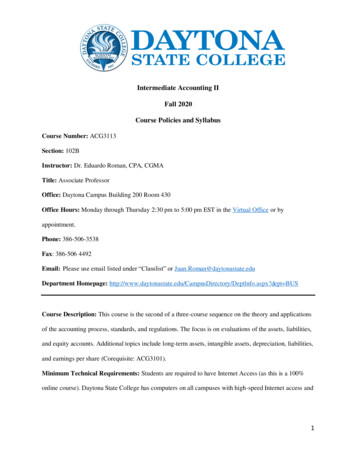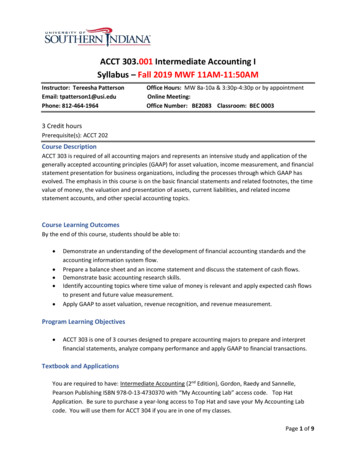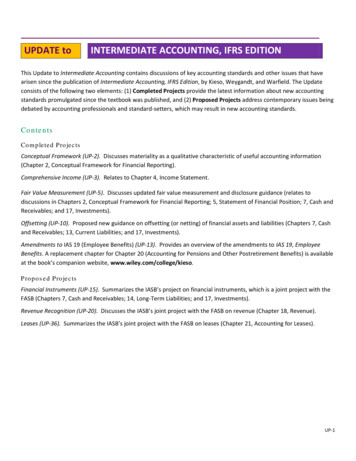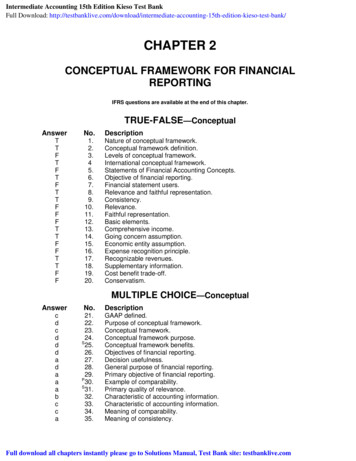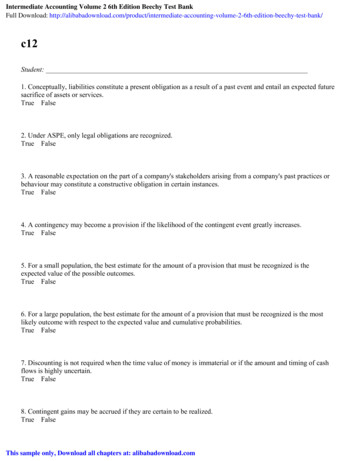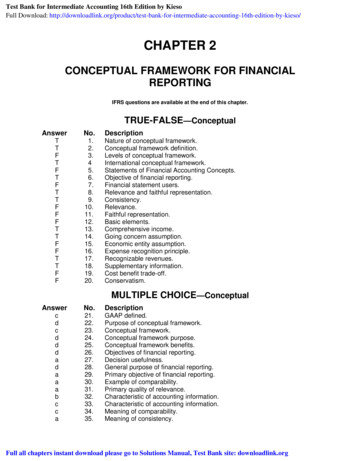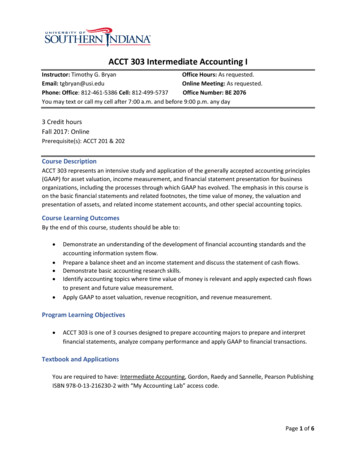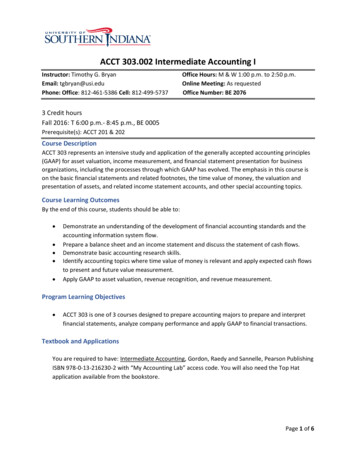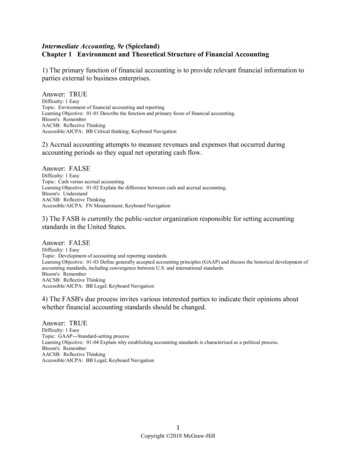
Transcription
Intermediate Accounting, 9e (Spiceland)Chapter 1 Environment and Theoretical Structure of Financial Accounting1) The primary function of financial accounting is to provide relevant financial information toparties external to business enterprises.Answer: TRUEDifficulty: 1 EasyTopic: Environment of financial accounting and reportingLearning Objective: 01-01 Describe the function and primary focus of financial accounting.Bloom's: RememberAACSB: Reflective ThinkingAccessible/AICPA: BB Critical thinking; Keyboard Navigation2) Accrual accounting attempts to measure revenues and expenses that occurred duringaccounting periods so they equal net operating cash flow.Answer: FALSEDifficulty: 1 EasyTopic: Cash versus accrual accountingLearning Objective: 01-02 Explain the difference between cash and accrual accounting.Bloom's: UnderstandAACSB: Reflective ThinkingAccessible/AICPA: FN Measurement; Keyboard Navigation3) The FASB is currently the public-sector organization responsible for setting accountingstandards in the United States.Answer: FALSEDifficulty: 1 EasyTopic: Development of accounting and reporting standardsLearning Objective: 01-03 Define generally accepted accounting principles (GAAP) and discuss the historical development ofaccounting standards, including convergence between U.S. and international standards.Bloom's: RememberAACSB: Reflective ThinkingAccessible/AICPA: BB Legal; Keyboard Navigation4) The FASB's due process invites various interested parties to indicate their opinions aboutwhether financial accounting standards should be changed.Answer: TRUEDifficulty: 1 EasyTopic: GAAP―Standard-setting processLearning Objective: 01-04 Explain why establishing accounting standards is characterized as a political process.Bloom's: RememberAACSB: Reflective ThinkingAccessible/AICPA: BB Legal; Keyboard Navigation1Copyright 2018 McGraw-Hill
5) Accounting for stock-based compensation is an area in which the FASB has received littlepolitical interference.Answer: FALSEDifficulty: 1 EasyTopic: GAAP―Standard-setting processLearning Objective: 01-04 Explain why establishing accounting standards is characterized as a political process.Bloom's: RememberAACSB: Reflective ThinkingAccessible/AICPA: BB Legal; Keyboard Navigation6) The Public Reform and Investor Protection Act of 2002 (Sarbanes-Oxley) changed the entityresponsible for setting auditing standards in the United States.Answer: TRUEDifficulty: 1 EasyTopic: Encouraging high-quality financial reportingLearning Objective: 01-05 Explain factors that encourage high-quality financial reporting.Bloom's: RememberAACSB: Reflective ThinkingAccessible/AICPA: BB Legal; Keyboard Navigation7) A rules-based approach to standard-setting stresses professional judgment as opposed tofollowing a list of rules.Answer: FALSEDifficulty: 1 EasyTopic: Encouraging high-quality financial reportingLearning Objective: 01-05 Explain factors that encourage high-quality financial reporting.Bloom's: RememberAACSB: Reflective ThinkingAccessible/AICPA: BB Critical thinking; Keyboard Navigation8) Under federal securities laws, the SEC has the authority to set accounting standards in theUnited States.Answer: TRUEDifficulty: 1 EasyTopic: Development of accounting and reporting standardsLearning Objective: 01-03 Define generally accepted accounting principles (GAAP) and discuss the historical development ofaccounting standards, including convergence between U.S. and international standards.Bloom's: RememberAACSB: Reflective ThinkingAccessible/AICPA: BB Legal; Keyboard Navigation9) The primary responsibility for properly applying GAAP when communicating with investorsand creditors through financial statements lies with a firm's auditors.Answer: FALSEDifficulty: 1 EasyTopic: Encouraging high-quality financial reportingLearning Objective: 01-05 Explain factors that encourage high-quality financial reporting.Bloom's: RememberAACSB: Reflective ThinkingAccessible/AICPA: BB Critical thinking; Keyboard Navigation2Copyright 2018 McGraw-Hill
10) Auditors play an important role in the resource allocation process by adding credibility tofinancial statements.Answer: TRUEDifficulty: 1 EasyTopic: Encouraging high-quality financial reportingLearning Objective: 01-05 Explain factors that encourage high-quality financial reporting.Bloom's: UnderstandAACSB: Reflective ThinkingAccessible/AICPA: BB Critical thinking; Keyboard Navigation11) The purpose of the conceptual framework is to provide a structure and framework for aconsistent set of GAAP.Answer: TRUEDifficulty: 1 EasyTopic: Conceptual framework―PurposeLearning Objective: 01-06 Explain the purpose of the conceptual framework.Bloom's: RememberAACSB: Reflective ThinkingAccessible/AICPA: BB Critical thinking; Keyboard Navigation12) In the United States, the conceptual framework indicates GAAP when a more specificaccounting standard does not apply.Answer: FALSEDifficulty: 1 EasyTopic: Conceptual framework―PurposeLearning Objective: 01-06 Explain the purpose of the conceptual framework.Bloom's: RememberAACSB: Reflective ThinkingAccessible/AICPA: BB Critical thinking; Keyboard Navigation13) Materiality can be affected by the dollar amount of an item, the nature of the item, or both.Answer: TRUEDifficulty: 1 EasyTopic: Concepts―Qualitative characteristicsLearning Objective: 01-07 Identify the objective and qualitative characteristics of financial reporting information, and theelements of financial statements.Bloom's: RememberAACSB: Reflective ThinkingAccessible/AICPA: BB Critical thinking; FN Measurement; Keyboard Navigation14) According to the FASB's Statements of Financial Accounting Concepts, conservatism is adesired qualitative characteristic of accounting information.Answer: FALSEDifficulty: 1 EasyTopic: Concepts―Qualitative characteristicsLearning Objective: 01-07 Identify the objective and qualitative characteristics of financial reporting information, and theelements of financial statements.Bloom's: RememberAACSB: Reflective ThinkingAccessible/AICPA: BB Critical thinking; FN Measurement; Keyboard Navigation3Copyright 2018 McGraw-Hill
15) Equity is a residual amount representing the owner's interest in the assets of the business.Answer: TRUEDifficulty: 1 EasyTopic: Concepts―Elements of financial statementsLearning Objective: 01-07 Identify the objective and qualitative characteristics of financial reporting information, and theelements of financial statements.Bloom's: RememberAACSB: Reflective ThinkingAccessible/AICPA: BB Critical thinking; FN Measurement; Keyboard Navigation16) Revenues are inflows or other enhancements of assets or settlements of liabilities fromactivities that constitute the entity's ongoing operations.Answer: TRUEDifficulty: 1 EasyTopic: Concepts―Elements of financial statementsLearning Objective: 01-07 Identify the objective and qualitative characteristics of financial reporting information, and theelements of financial statements.Bloom's: RememberAACSB: Reflective ThinkingAccessible/AICPA: BB Critical thinking; FN Measurement; Keyboard Navigation17) Gains or losses result, respectively, from the disposition of business assets for greater than,or less than, their book values.Answer: TRUEDifficulty: 1 EasyTopic: Concepts―Elements of financial statementsLearning Objective: 01-07 Identify the objective and qualitative characteristics of financial reporting information, and theelements of financial statements.Bloom's: RememberAACSB: Reflective ThinkingAccessible/AICPA: BB Critical thinking; FN Measurement; Keyboard Navigation18) Comprehensive income is another term for net income.Answer: FALSEDifficulty: 1 EasyTopic: Concepts―Elements of financial statementsLearning Objective: 01-07 Identify the objective and qualitative characteristics of financial reporting information, and theelements of financial statements.Bloom's: RememberAACSB: Reflective ThinkingAccessible/AICPA: BB Critical thinking; FN Measurement; Keyboard Navigation19) The FASB's conceptual framework lists relevance and timeliness as the two fundamentalqualitative characteristics of decision-useful information.Answer: FALSEDifficulty: 1 EasyTopic: Concepts―Qualitative characteristicsLearning Objective: 01-07 Identify the objective and qualitative characteristics of financial reporting information, and theelements of financial statements.Bloom's: RememberAACSB: Reflective ThinkingAccessible/AICPA: BB Critical thinking; FN Measurement; Keyboard Navigation4Copyright 2018 McGraw-Hill
20) The monetary unit assumption requires that items in financial statements be measured in aparticular monetary unit.Answer: TRUEDifficulty: 1 EasyTopic: GAAP―Underlying assumptionsLearning Objective: 01-08 Describe the four basic assumptions underlying GAAP.Bloom's: RememberAACSB: Reflective ThinkingAccessible/AICPA: BB Critical thinking; FN Measurement; Keyboard Navigation21) The periodicity assumption requires that present value calculations take into account thenumber of compounding periods in each year.Answer: FALSEDifficulty: 1 EasyTopic: GAAP―Underlying assumptionsLearning Objective: 01-08 Describe the four basic assumptions underlying GAAP.Bloom's: RememberAACSB: Reflective ThinkingAccessible/AICPA: BB Critical thinking; FN Measurement; Keyboard Navigation22) Determining fair value by calculating the present value of future cash flows is a level 1 typeof input.Answer: FALSEDifficulty: 1 EasyTopic: Concepts―Recognition - Measurement - DisclosureLearning Objective: 01-09 Describe the recognition, measurement, and disclosure concepts that guide accounting practice.Bloom's: RememberAACSB: Reflective ThinkingAccessible/AICPA: BB Critical thinking; FN Measurement; Keyboard Navigation23) The FASB's framework for measuring fair value doesn't change the situations in which fairvalue is used under current GAAP.Answer: TRUEDifficulty: 1 EasyTopic: Concepts―Recognition - Measurement - DisclosureLearning Objective: 01-09 Describe the recognition, measurement, and disclosure concepts that guide accounting practice.Bloom's: RememberAACSB: Reflective ThinkingAccessible/AICPA: BB Critical thinking; FN Measurement; Keyboard Navigation24) The revenue/expense approach emphasizes determining the appropriate amounts of revenueand expense in each reporting period.Answer: TRUEDifficulty: 1 EasyTopic: Evolving GAAPLearning Objective: 01-10 Contrast a revenue/expense approach and an asset/liability approach to accounting standard setting.Bloom's: RememberAACSB: Reflective ThinkingAccessible/AICPA: BB Critical thinking; FN Measurement; Keyboard Navigation5Copyright 2018 McGraw-Hill
25) The asset/liability approach emphasizes matching to determine what assets and liabilitiesshould be reflected on the balance sheet.Answer: FALSEDifficulty: 1 EasyTopic: Evolving GAAPLearning Objective: 01-10 Contrast a revenue/expense approach and an asset/liability approach to accounting standard setting.Bloom's: RememberAACSB: Reflective ThinkingAccessible/AICPA: BB Critical thinking; FN Measurement; Keyboard Navigation26) In IFRS, the conceptual framework indicates appropriate accounting when a more specificaccounting standard does not apply.Answer: TRUEDifficulty: 1 EasyTopic: International Financial Reporting StandardsLearning Objective: 01-11 Discuss the primary differences between U.S. GAAP and IFRS with respect to the development ofaccounting standards and the conceptual framework underlying accounting standards.Bloom's: RememberAACSB: DiversityAccessible/AICPA: BB Global; Keyboard Navigation27) Political pressure never affects the IFRS standard-setting process.Answer: FALSEDifficulty: 1 EasyTopic: International Financial Reporting StandardsLearning Objective: 01-11 Discuss the primary differences between U.S. GAAP and IFRS with respect to the development ofaccounting standards and the conceptual framework underlying accounting standards.Bloom's: RememberAACSB: DiversityAccessible/AICPA: BB Global; BB Legal; Keyboard Navigation28) External decision makers would not look primarily to financial accounting information toassist them in making decisions on:A) Granting credit.B) Capital budgeting.C) Selecting stocks.D) Mergers and acquisitions.Answer: BDifficulty: 1 EasyTopic: Environment of financial accounting and reportingLearning Objective: 01-01 Describe the function and primary focus of financial accounting.Bloom's: UnderstandAACSB: Reflective ThinkingAccessible/AICPA: BB Resource management; Keyboard Navigation6Copyright 2018 McGraw-Hill
29) Corporations issue their shares to the investing public in the:a.b.c.d.Primary marketYesNoYesNoSecondary marketYesYesNoNoA) Option a.B) Option b.C) Option c.D) Option d.Answer: CDifficulty: 1 EasyTopic: Environment of financial accounting and reportingLearning Objective: 01-01 Describe the function and primary focus of financial accounting.Bloom's: RememberAACSB: Reflective ThinkingAccessible/AICPA: BB Resource management; Keyboard Navigation30) The primary focus for financial accounting information is to provide information useful for:a.b.c.d.Investing decisionsYesYesNoNoCredit decisionsYesNoYesNoA) Option a.B) Option b.C) Option c.D) Option d.Answer: ADifficulty: 1 EasyTopic: Environment of financial accounting and reportingLearning Objective: 01-01 Describe the function and primary focus of financial accounting.Bloom's: RememberAACSB: Reflective ThinkingAccessible/AICPA: BB Resource management; FN Risk analysis; Keyboard Navigation7Copyright 2018 McGraw-Hill
31) Which of the following groups is not among the external users for whom financialstatements are prepared?A) Customers.B) Suppliers.C) Employees.D) Customers, suppliers, and employees are all external users of financial statements.Answer: DDifficulty: 1 EasyTopic: Environment of financial accounting and reportingLearning Objective: 01-01 Describe the function and primary focus of financial accounting.Bloom's: RememberAACSB: Reflective ThinkingAccessible/AICPA: BB Critical thinking; FN Risk analysis; Keyboard Navigation32) Whi
Intermediate Accounting, 9e (Spiceland) Chapter 1 Environment and Theoretical Structure of Financial Accounting 1) The primary function of financial accounting is to provide relevant financial information to parties external to business enterprises. Answer: TRUE Difficulty: 1 Easy Topic: Environment of financial accounting and reporting




